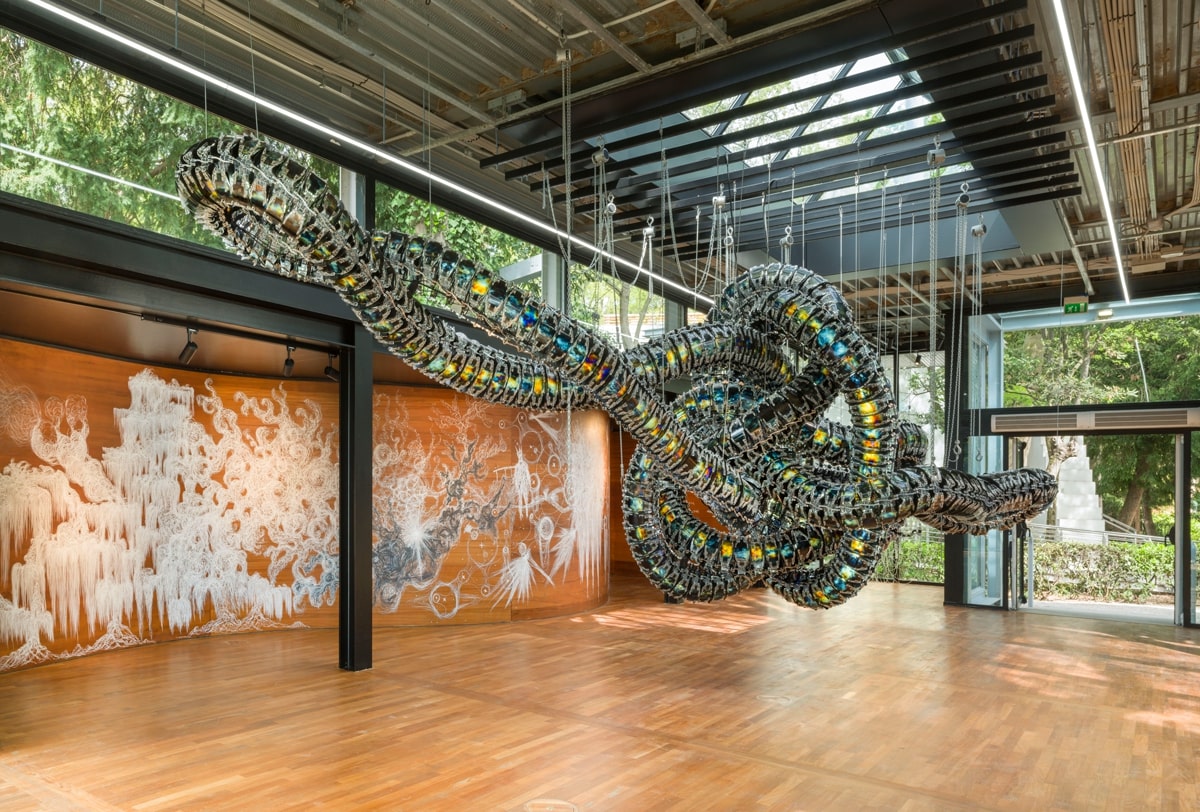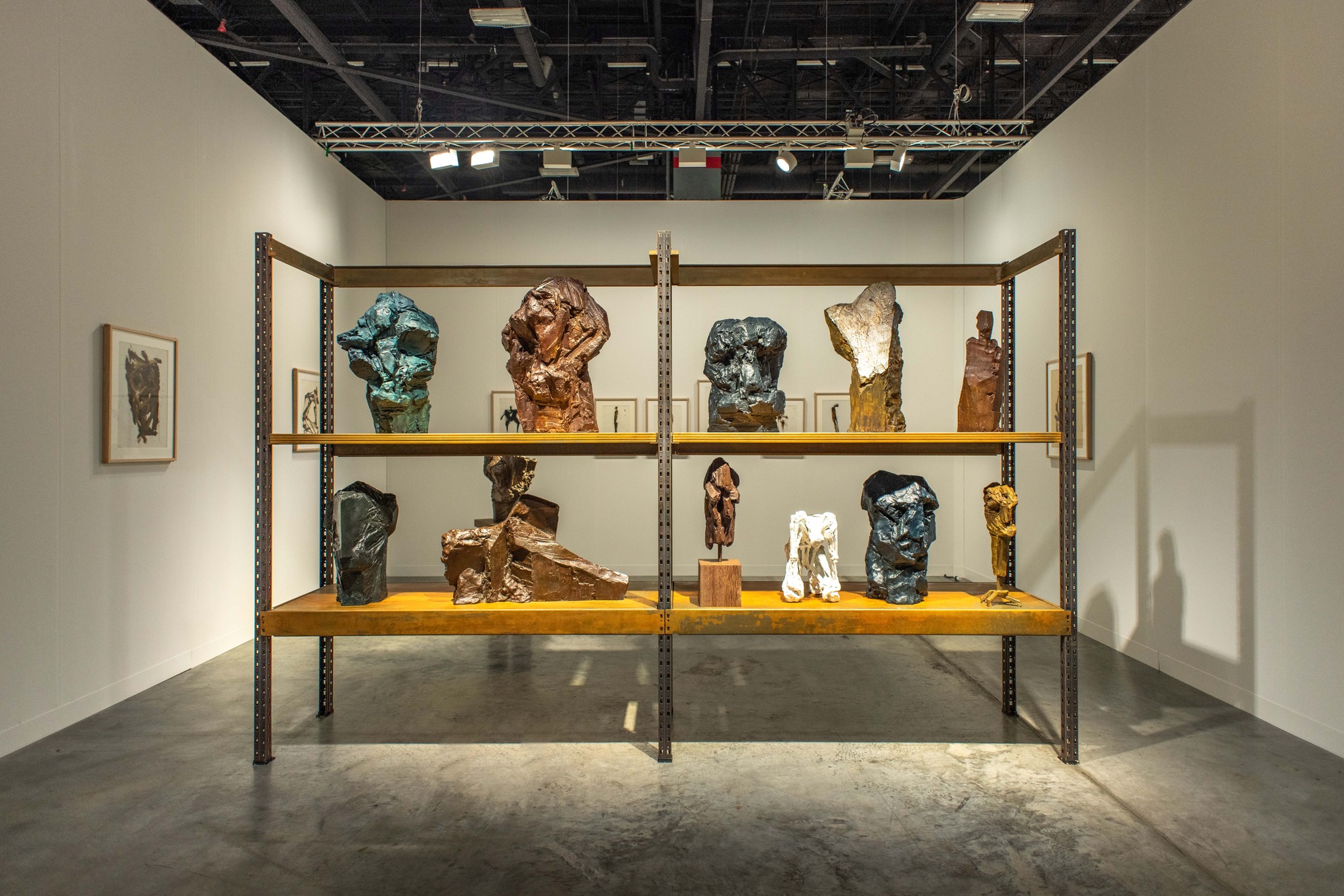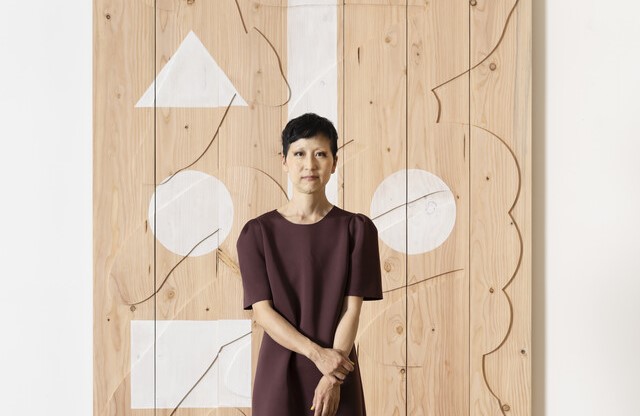Yunchul Kim
(b. 1970) is an electronic music composer and visual artist who has worked with
installation, drawing, sound, text, and various media. Kim, who has asked
fundamental questions about “material” since studying abroad in Germany, has explored
the possibilities of imagination and the creation of another reality that goes
beyond the realm of human experience, paying attention to its potential
tendencies.
He
integrates diverse references such as mathematics, science, technology, music,
philosophy, literature, and cosmology into his work, capturing and exposing the
fluid encounters between objects, including non-human materials. Through this,
he transforms the material entanglements of the universe into artistic form.

Yunchul Kim, Self_portrait.jpg, 2003 ©Yunchul Kim
Kim studied electronic music in Korea
and later went to Germany to study media art. In his early career, he focused
primarily on immaterial works like sound art, media art through projections,
and generative art. While living in a foreign land where everything felt
unfamiliar, one day he suddenly felt a sense of futility in working on a
computer that could vanish at the push of a power button. This led him to want
to work with materials that he could physically grasp.
Deciding to work with his hands rather
than a computer, he began creating Self_portrait.jpg (2003).
Seemingly abstract at first glance, Self_portrait.jpg
involved transcribing about 140,000 characters of code, which digitally
translated his own facial image, onto paper over the span of three months,
embodying repetitive labor.
This work marked a significant turning
point in his practice, shifting from immaterial to material-focused art. During
this process, he experienced materiality and temporality through the changing
condition of the paper, influenced by the warmth of his hand, weather, and
physical fatigue, which would later become key elements in his work.
 Yunchul Kim, Epiphora,
2009 ©Yunchul Kim
Yunchul Kim, Epiphora,
2009 ©Yunchul KimIn 2009, Kim presented Epiphora, a work that began as an exploration of the properties of water, specifically liquid. This kinetic installation featured black ferrofluid, enclosed in transparent liquid, that pulsated, circulated, and interacted through machine-like devices resembling bodily organs. This work marked the beginning of Kim’s development of artworks incorporating fluid mechanics and electromagnetic devices.

김윤철, 〈Effulge〉, 2012-2014 ©김윤철
In 2010,
he participated in the Kunstlerhaus Bethanien residency program in Germany,
where he expanded his artistic world by interacting with experts not only from
the arts but also from scientific fields.
Building
on this experience, Kim created Effulge (2012-2014), a fluid
mechanics installation featuring golden photonic crystals that moved under
pressure, which he designed. In 2016, he was awarded the prestigious Collide
International Award by CERN, recognizing artists who contribute to the creative
fusion of science and art.
 Yunchul Kim, Argos,
2018 ©Yunchul Kim
Yunchul Kim, Argos,
2018 ©Yunchul KimIn
2018, Kim Yunchul’s works Impulse and Argos, commissioned by CERN, demonstrated
a technical expansion while reflecting the artist’s contemplation of the
relationship between materials and humans, specifically between the non-human
and human.
The
work Argos is a 41-channel muon particle detector. It reacts
with a flash each time a muon particle emitted by the universe is detected in
the air – a mechanism that is carried over to another work titled Impulse.
Impulse is a work consisting of numerous cylindrical tubes
that extend out like the hanging branches of a tree as clear fluid flows
through them. Impulse responds to signals from Argos
whenever particles are detected, causing the internal liquid to move.
 Yunchul Kim, Impulse,
2018 ©Yunchul Kim
Yunchul Kim, Impulse,
2018 ©Yunchul KimIn this dynamic interaction between the two machines, human viewers witness a new form of creation resulting from the organic and active relationship between the two. Within this universe of objects, humans are not positioned at the center but rather become equal participants in the network of interactions these entities generate.
 Yunchul Kim, Coptic
Light, 2019 ©Barakat Contemporary
Yunchul Kim, Coptic
Light, 2019 ©Barakat ContemporaryMeanwhile, Coptic Light
(2019) is a planar mechanical work that utilizes the molecular structure of
hydrogel, a water-soluble gelatin. This piece involves applying immense
pressure to the hydrogel, altering its molecular structure. Fluorescent filters
are installed on the front and back, allowing light to pass through. As the
light refracts through the altered molecular structure, it acts like a prism,
creating self-generated patterns and colors.
In this way, the machines in Yunchul
Kim’s works go beyond merely operating mechanical functions. They serve as
catalysts that reveal the inherent tendencies of the material itself.

Yunchul Kim, La Poussière de soleils (Dust of Suns), 2022 ©Yunchul Kim
In 2022, Kim was selected as the artist for the Korean Pavilion at the Venice Biennale, once again drawing international attention. His new work, La Poussière de soleils (Dust of Suns), continued the aesthetic exploration of the inherent structures and tendencies of materials, a recurring theme in his previous works.
 Yunchul Kim, Dust
of Suns II,(detail) 2022 ©Yunchul Kim
Yunchul Kim, Dust
of Suns II,(detail) 2022 ©Yunchul KimLa Poussière de soleils (Dust of
Suns) was inspired by the philosophical exploration of machines,
humans, life, and death found in the French writer Raymond Roussel’s novel Poussière
de Soleil. For this piece, Kim pulverized stones that had been buried
underground for thousands of years, transforming them into nano-sized
particles. These particles were then turned into a fluid that, when in motion,
acted like a prism, creating a spectrum of colors.
The colors produced by this molecular structure are
referred to as structural colors in science. Unlike colors assigned by humans,
structural colors are created by the material’s structure itself. This idea
aligns with Kim’s philosophical view of the material as an “active agent.”
 Yunchul Kim, CHROMA
V, 2022, Installation view of Korean Pavilion at the Venice Biennale
2022 ©Yunchul Kim. Photo: Roman März
Yunchul Kim, CHROMA
V, 2022, Installation view of Korean Pavilion at the Venice Biennale
2022 ©Yunchul Kim. Photo: Roman MärzAt the Venice Biennale, Yunchul Kim
also presented the fifth series of his renowned work CHROMA.
The large-scale installation CHROMA V, measuring 8 meters,
is composed of curved surfaces and kinetic devices that fill 382 individual
cells. Each surface is filled with hydrogel, and as the kinetic mechanisms
surrounding the material move, the hydrogel subtly deforms, naturally revealing
its inherent vibrant colors.
Through the vortex-like knot structure
of CHROMA, Kim aimed to visualize a form and force that have
no clear beginning or end. To create the numerous loops in this work, he had to
engage with the abstract realm of mathematics. In topology, a mathematical
discipline, the creation of knots from a series of numerical sequences
signifies the formation of new dimensions.
 Yunchul Kim,
CHROMA IX, 2024 ©Yunchul Kim
Yunchul Kim,
CHROMA IX, 2024 ©Yunchul KimFrom this cyclical knot structure, Kim
discovers a nonlinear state of the world that existed before language. The
ambiguous cycle of CHROMA’s structure suggests an endless
entanglement of the unconscious, reality, matter, nature, and religion,
inviting viewers to imagine another form of reality.
In this way, Yunchul Kim’s works transcend
being mere mechanical devices or fixed forms of matter. Instead, they exist as
non-human agents that interact with other works, humans, and the world, forming
organic relationships. Within the exhibition space, these agents create a vast
sensory network. The audience, through bodily engagement, experiences the light
or sound emitted by the machines as an "affective experience,"
becoming intertwined within this relational web.
“I believe art holds true aesthetic
value when it is fully liberated from language. (...) As an artist, my goal is
to create works that approach the audience not symbolically but
symptomatically.
I want to show spatial and temporal
depth, a different dimension of sensibility. It is closer to the realm of
punctum rather than studium, meaning it is more bodily and sensory than
rational or semiotically analyzable.”
(Leepoétique,
Interview with Yunchul Kim, November 21, 2019)

Artist Yunchul Kim ©Yunchul Kim
Yunchul Kim works internationally
currently based in Seoul, Korea. He has been the recipient of a number of
international awards, including the 2016 Collide Award from CERN, the world’s largest
particle physics research institute, the VIDA 15.0 Third Prize, along with
awards at Ars Electronica and Transmediale.
Kim was chief researcher of the
research group Mattereality at the Transdisciplinary Research Program at the
Korea Institute for Advanced Study. He is a member of the art and science
project group Fluid Skies as well as Liquid Things, an artistic research
project at the Art and Science Department of the University of Applied Arts,
Vienna, Austria.
His works have been presented by a
number of renowned international organizations, including CCCB (Centre de
Cultura Contemporània de Barcelona), Spain; FACT (Foundation for Art and
Creative Technology), Liverpool, UK; Ars Electronica, Linz, Austria; Frankfurt
Museum of Art, Germany; International Triennial of New Media Art, Beijing,
China; VIDA15.0, Spain; Schering Stiftung, Berlin; Transmediale, Berlin; and
the 6th Electrohype, Ystad Sweden.
References
- 김윤철, Yunchul Kim (Artist Website)
- 바라캇 컨템포러리, 김윤철 (Barakat Contemporary, Yunchul Kim)
- 바라캇 컨템포러리, 김윤철: GLARE (Barakat Contemporary, Yunchul Kim: GLARE)
- 메종코리아, 베니스 비엔날레의 자이어, 2022.04.07
- 국립현대미술관, 임민욱 | 국제호출주파수 | 2011 (National Museum of Modern and Contemporary Art Korea (MMCA), Minouk Lim | International Calling Frequency | 2011)
- 리포에틱, 김윤철 인터뷰, 2019.11.21




















